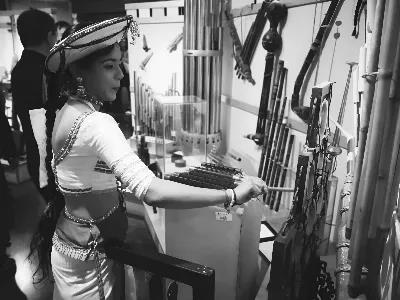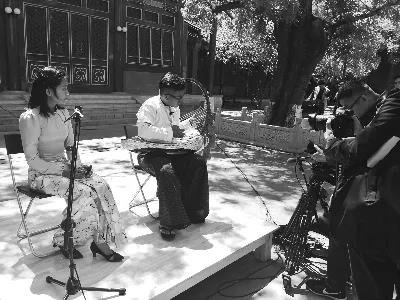
On April 29, solstice and May 1, the second 3-day "One Belt And One Road" music education alliance conference was held at the central conservatory of music. From college of music, art colleges and universities all over the country music 20 dean of the college with Russia, Ukraine, Turkey, Iran, South Korea, India, Singapore, myanmar and other 30 countries and regions of the dean of college of music, art, musicians gathered, plan for "neighbourhood" all the way along the national music education with the development of the future.

Audiences experience the musical instrument exhibition "One Belt And One Road"

Performance interaction on campus of central conservatory of music (li yue/photo)
Focus on music
Establish communication mechanism
In response to and serving the national "One Belt And One Road" initiative and the implementation of the "One Belt And One Road" education action plan of the ministry of education, the central conservatory of music successfully held the "One Belt And One Road" music education alliance founding conference and music academic seminar and performance in May 2017. The "One Belt And One Road" music education alliance was also included in the list of outcomes of the "One Belt And One Road" international cooperation summit forum in 2017.
The second "One Belt And One Road" music education alliance conference was held to "understand. To share. Collaboration, organized by the central conservatory of music. The activities include dean's forum, "One Belt And One Road" music art performance, music academic lectures and workshops, which include academic discussions on music culture and education as well as communication and interaction on music performance. Yu feng, President of the central conservatory of music, said that the activity aims to establish a communication mechanism between the "One Belt And One Road" music education alliance colleges and universities, so as to deepen the friendship and mutual understanding between the alliance colleges and universities, promote the improvement of the teaching level of the alliance colleges and universities, and promote the prosperity and development of world music.
It is understood that "One Belt And One Road" music education league since its establishment has achieved fruitful results, for example, has conducted a diversity of "area" music education communication and performance, to create and perform a batch of "area" music original works, organized a "neighbourhood" music and music education research topic, edit published essays on the silk road music... "Area" music education alliance said carda r, director of the organizing committee, practice shows that "One Belt And One Road" music education alliance has built international music education exchanges and cooperation platform for the new, expanded the music education opened a new space, for "neighbourhood" all the way along the national music education communion, mutual learning, innovation and development provides new opportunities.
Interactive performance
Use music to bring each other closer
In order to better demonstrate the colorful musical charm of the countries along the belt and road and promote the connection between the peoples of the countries along the belt and road, the conference also held a series of performances such as musical instrument exhibition "One Belt And One Road", "One Belt And One Road" music education alliance achievement exhibition, "One Belt And One Road" special concert of diversified music culture.
Among them, "One Belt And One Road" musical instrument exhibition not only shows the types and development history of Musical Instruments of countries along the "One Belt And One Road" route in the form of pictures and words, but also exhibits the actual Musical Instruments of countries along the "One Belt And One Road" route, including liuqin and huqin of China, panpipes and xylophone of Thailand, bangla drum of Bangladesh, etc. These Musical Instruments are made of various materials and shapes. During the visit, some guests even picked up their own Musical Instruments and performed impromptu with great interest, so as to satisfy the audience.
Yu feng introduced that in history, many ethnic Musical Instruments were introduced into China through "One Belt And One Road", such as pipa, suona and dulcimer. And Chinese music is also spread to other countries and regions through "One Belt And One Road". "It can be seen that the appearance of world music today and the diverse musical cultures are the result of mutual exchanges between countries." YuFeng said.
In addition to the musical instrument exhibition, this event specially invited musicians from myanmar, Sri Lanka and India to play interactive performances on the campus of the central conservatory of music, attracting many audiences to stop and watch. "Being able to enjoy music from different countries not only broadens our horizons, but also gives us a better sense of the charms of music from other countries." "An audience member told reporters.
Dean of the BBS
Share music education experience
"Dean's forum" is the highlight of "One Belt And One Road" music education alliance conference. On the spot, the guests introduced the music education situation of their respective countries and regions, as well as the music education achievements of their schools, and had in-depth exchanges on the sharing and cooperation of music education resources, as well as the uniqueness of music education in different countries.
Chan Tze Law, deputy dean of the yeung hsiu tao conservatory of music in Singapore, said the event has opened the eyes of musicians and music educators from all over the world to the bright future of the development of world music. "Music educators should think about how to have a global perspective and bring students up to date." Chan Tze Law says his school has partnerships with schools in 14 countries, including the central conservatory of music. In the future, I hope to conduct more cooperation with music schools in countries along the "One Belt And One Road" to better promote the construction and development of "One Belt And One Road".
Abdul Ghafour Al Heeti, director of the Qatar conservatory of music, said that the teachers of the Qatar conservatory of music are professional music performing artists with rich stage experience, but educational experience needs to be further accumulated. He suggested that relevant colleges and universities of "One Belt And One Road" music education alliance could hold regular seminars on education and teaching, and share their progress and achievements in music education with alliance members in the form of monthly reports, so as to promote the development of music education in "One Belt And One Road" countries.
Adrian Charles Walter, President of the Hong Kong academy for performing arts, stressed the importance of "collaboration" in music education. He said that the Hong Kong academy for performing arts has achieved good results by cooperating with art institutions and performance companies to integrate art courses with off-campus practice. He believes that the role of social institutions in art education should be brought into full play.
At the closing ceremony of the "One Belt And One Road" music education alliance conference held on May 1, the central conservatory of music signed the membership agreement with 17 new entrants, including the national university of the arts of Argentina, the Albanian academy of arts and the ho chi minh conservatory of music of Vietnam. So far, there are 61 member universities, including 37 from abroad and 24 from home.
"The One Belt And One Road music education alliance is an important platform to showcase the diversity of music cultures around the world." Zhao min, party secretary of the central conservatory of music, said that the conference has deepened the inter-relationship between the alliance institutions and laid a foundation for further exchanges and cooperation in the future. In the future, the alliance will further innovate the system and mechanism, integrate internal and external resources, build a number of high-quality projects, and carry out in-depth exchanges and cooperation in the field of humanities, so that more people will benefit from "One Belt And One Road" music education.